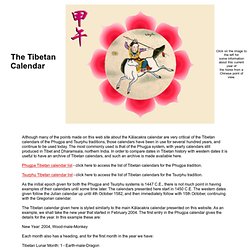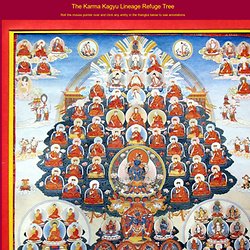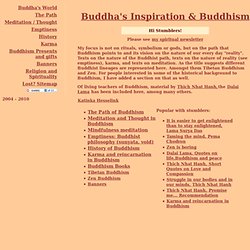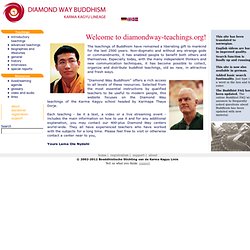

Calendar. Although many of the points made on this web site about the Kālacakra calendar are very critical of the Tibetan calendars of the Phugpa and Tsurphu traditions, those calendars have been in use for several hundred years, and continue to be used today.

The most commonly used is that of the Phugpa system, with yearly calendars still produced in Tibet and Dharamsala, northern India. In order to compare dates in Tibetan history with western dates it is useful to have an archive of Tibetan calendars, and such an archive is made available here. Phugpa Tibetan calendar list - click here to access the list of Tibetan calendars for the Phugpa tradition.
Ji Csing - A változás könyve. Interpreting The I Ching. NoZen. Buddhist Geeks by Personal Life Media. The Fundamentals of Meditation. ZEN. Lojong and Tonglen Community Site. Dealing with Disturbing Emotions: Attachment. Alexander BerzinRiga, Latvia, July 2004 Unedited Transcript Listen to the audio version of this page (1:10 hours): Download the audio file This evening we’re going to be speaking about how to deal with our disturbing emotions.

Well, first of all, what is a “disturbing emotion?” That’s the first question. And of course, with attachment and longing desire, that could lead us to act destructively – to go out and steal something, for example. But it could also lead – let’s say we’re angry about the injustice of a certain system or a certain situation – and we’re so angry with it that we actually do something to try to change it. And even if we do help in a situation where it is appropriate for helping the other person, we’re not relaxed about it, because we are expecting something in return. So, whether we act in a destructive way or we act in a constructive way, if it’s motivated by and accompanied by a disturbing emotion, it’s going to cause problems.
So, love is mixed. Keith Dowman. Dharma Media - Rime Buddhist Archives. Buddhist Spiritual Art: 21 Taras: Joan Bredin Price: The Twenty-One Taras Images. Mahatanhasankhaya Sutta: The Greater Craving-Destruction Discourse. This sutta teaches how to understand the relationship of consciousness to rebirth in a way that helps put an end to rebirth.

Although the Buddha never used any word corresponding to "rebirth" in his teachings, he did describe birth as a process following on death again and again as long as the appropriate conditions are present. In other words, even though he didn't use the word "rebirth," his teachings on birth are teachings on repeated birth: how it happens, how it inherently involves suffering and stress, and how it can be brought to an end. The idea that death can be followed by birth was not universally accepted in India in the Buddha's time.
As DN 2 and MN 101 show, some prominent contemplative schools actively rejected the idea of rebirth while others affirmed it. Thus when the Buddha taught rebirth, he wasn't simply following an unexamined cultural assumption. There is no way to happiness, happiness is the way. Refuge Tree. The Karma Kagyu Lineage Refuge Tree Roll the mouse pointer over and click any entity in the thangka below to see annotations Ngondro Text.

I Ching Interpretation & Meaning Hexagram 17 - Sui. Collection of Mudras. Meditation Quotes Meditation Sayings, Quotes on Meditation, Spiritual Quotes on Meditation. Buddha's World & Buddhism. Hi Stumblers!

Please see my spiritual newsletter My focus is not on rituals, symbolism or gods, but on the path that Buddhism points to and its vision on the nature of our every day "reality". Texts on the nature of the Buddhist path, texts on the nature of reality (see emptiness), karma, and texts on meditation. As the title suggests different Buddhist lineages are represented here. Amongst them Tibetan Buddhism and Zen. Of living teachers of Buddhism, material by Thich Nhat Hanh,the Dalai Lama has been included here, among many others. Katinka Hesselink. eBooks: Mahayana Text & Teachings. Buddhism - The Four Noble Truths, The Eightfold Path, Karma and Meditation Practice. Diamondway-Teaching.Org.
This site has been translated to norwegian.

English videos are back in improved quality. Search function is finally up and running.This site is now also available in german. Added basic search funtionality. Just type in a word in the box and hit enter. The Buddhist FAQ has been updated. Welcome to diamondway-teachings.org! The teachings of Buddhism have remained a liberating gift to mankind for the last 2500 years. "Diamond Way Buddhism" offers a rich access to all levels of these resources. Each teaching - be it a text, a video or a live streaming event - includes the main information on how to use it and for any additional explanation, you may contact our 400-plus Diamond Way centers world-wide. Yours Lama Ole Nydahl. Om Mani Padme Hum: The Meaning of the Mantra in Tibetan Buddhism. Glimpsing a Few More Facets of the Mantra There are many ways to understand the meaning of the mantra.

Here are a few of them: The Transformation of Speech [An excerpt from The Dharma, by Kalu Rinpoche, from a chapter on The Four Dharmas of Gampopa. ] "The second aspect of transformation [of confusion into wisdom] concerns our speech. Mere words, which have no ultimate reality, can determine our happiness and suffering. Zen Koans - AshidaKim.com. Welcome to Audio Dharma.